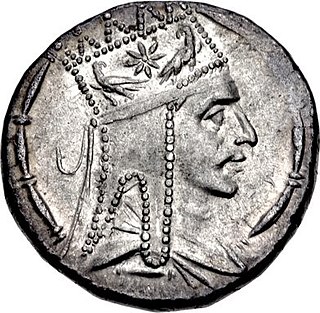
Tigranes II, more commonly known as Tigranes the Great, was a king of Armenia. A member of the Artaxiad dynasty, he ruled from 95 BC to 55 BC. Under his reign, the Armenian kingdom expanded beyond its traditional boundaries and reached its peak, allowing Tigranes to claim the title Great King or King of Kings. His empire for a short time was the most powerful state to the east of the Roman Republic.
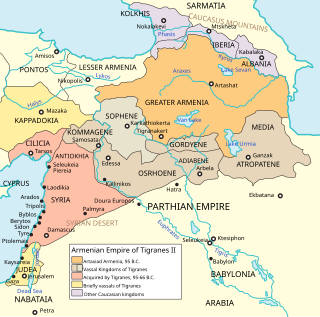
Armenia, also the Kingdom of Greater Armenia, or simply Greater Armenia sometimes referred to as the Armenian Empire, was a kingdom in the Ancient Near East which existed from 331 BC to 428 AD. Its history is divided into the successive reigns of three royal dynasties: Orontid, Artaxiad and Arsacid (52–428).
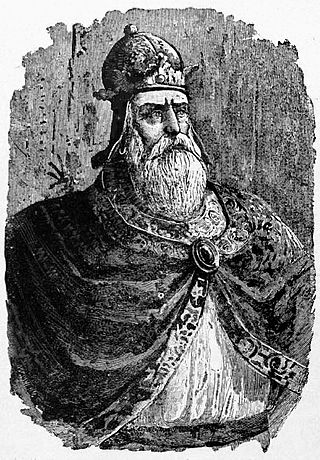
Tiridates III, also known as Tiridates the Great or Tiridates IV, was the Armenian Arsacid king from c. 298 to c. 330. In the early 4th century, Tiridates proclaimed Christianity as the state religion of Armenia, making the Armenian kingdom the first state to officially embrace Christianity.

Artavasdes II was king of Armenia from 55 BC to 34 BC. A member of the Artaxiad dynasty, he was the son and successor of Tigranes the Great, who ascended the throne of a still powerful and independent state. His mother was Cleopatra of Pontus, thus making his maternal grandfather the prominent Pontus king Mithridates VI Eupator. Like his father, Artavasdes continued using the title of King of Kings, as seen from his coins.
Mirian I was a king of Iberia who reigned in the 2nd century BC. An adopted son of his father-in-law King Sauromaces I, he was a Persian-born prince but governed over Iberia as a member of the Pharnavazid dynasty.

Artaxias I was the founder of the Artaxiad dynasty of Armenia, ruling from 189 BC to 160 BC. Artaxias was a member of a branch of the Orontid dynasty, the earlier ruling dynasty of Armenia. He expanded his kingdom on all sides, consolidating the territory of Greater Armenia. He enacted a number of administrative reforms to order his expanded realm. He also founded a new capital in the central valley of the Araxes River called Artaxata (Artashat), which quickly grew into a major urban and commercial center. He was succeeded by his son Artavasdes I.

Artaxias II, also known as Artaxes II and Artashes was a prince of the Kingdom of Armenia, member of the Artaxiad dynasty and King of Armenia from 34 BC until 20 BC.
The Arsacid dynasty, called the Arshakuni in Armenian, ruled the Kingdom of Armenia from 12 to 428. The dynasty was a branch of the Arsacid dynasty of Parthia. Arsacid kings reigned intermittently throughout the chaotic years following the fall of the Artaxiad dynasty until 62, when Tiridates I, brother of Parthian King Vologases I, secured Arsacid rule in Armenia as a client king of Rome. However, he did not succeed in establishing his line on the throne, and various princes of different Arsacid lineages ruled until the accession of Vologases II, who succeeded in establishing his own line on the Armenian throne, which ruled the kingdom until its abolishment by the Sasanian Empire in 428.
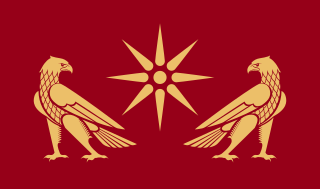
The Artaxiad dynasty ruled the Kingdom of Armenia from 189 BC until their overthrow by the Romans in 12 AD. Their realm included Greater Armenia, Sophene and intermittently Lesser Armenia and parts of Mesopotamia. Their main enemies were the Romans, the Seleucids and the Parthians, against whom the Armenians conducted multiple wars.
Erato was a queen of Armenia from the Artaxiad dynasty. She co-ruled as Roman client queen in 8–5 BC and 2 BC–AD 1 with Tigranes IV. After living in political exile for a number of years, she co-ruled as Roman client queen from 6 until 12 with Tigranes V, her distant paternal relative and possible second husband. She may be viewed as one of the last hereditary rulers of her nation.
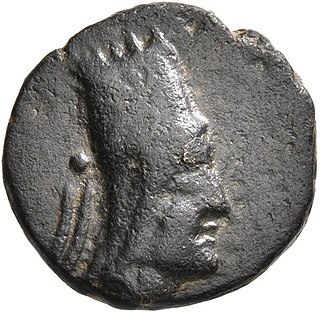
Tigranes I was an Artaxiad king of Armenia at the end of the 2nd and the beginning of the 1st century BC. Few records have survived about his and his predecessor Artavasdes I's reign, which has led to some confusion. Some modern scholars have doubted that such a king reigned at all. Other historians, such as Hakob Manandian, David Marshall Lang and Rouben Paul Adalian consider him a real figure but differ or are uncertain on the exact dates of his reign. Although it has been proposed that Tigranes I reigned from 123 BC to 96 BC, this view has been criticized. Another suggestion is that Tigranes I ruled in 120 BC - 95 BC and this has been recently corroborated by historian Christian Marek.
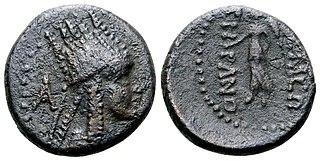
Tigranes III was a prince of the Kingdom of Armenia and member of the Artaxiad dynasty who served as a Roman client king of Armenia.
Tiran known also as Tigranes VII, Tigranes or Diran was an Armenian prince who served as a Roman client king of Arsacid Armenia from 339 until 350. He was a contemporary of and is associated with the life of Sarkis the Warrior and his son, Martiros.

Tigranes IV was a prince of the Kingdom of Armenia and member of the Artaxiad dynasty who served as a Roman client king of Armenia from 8 BC until 5 BC and 2 BC until 1 AD.
Satenik was an Alanian princess who, according to Armenian tradition, married Artashes, the king of Armenia. The Artashes in the tradition is identified with the 2nd-century BC king Artaxias I, although it is generally believed that the real historical basis for the story came from the invasion of Armenia by the Alans in the 1st century AD, during the reign of Tiridates I. The story of Artashes and Satenik forms a part of the ancient Armenian epic known as Vipasank῾, fragments of which are presented by the Armenian historian Movses Khorenatsi in his History of Armenia. Movses notes that the story, which he directly quotes from, was a well-known epic during his time among the common people of Armenia told by traveling storytellers and minstrels. The name and character of Satenik are connected with Satana, a figure in the folklore of the Ossetians and other peoples of the North Caucasus.

The Artaxiads, a branch of the eponymous dynasty of Armenia, ruled Iberia from c. 90 BC to 30 AD. According to the medieval Georgian chronicles, they acquired the crown of Iberia after the Iberian nobles revolted against their king P’arnajom, of the Pharnabazid dynasty, and petitioned the king of Armenia to send his son, who was married to a Pharnabazid princess, as their new monarch. Both the king of Armenia and his son are referred to in the chronicles as “Arshak”, probably a confusion with Artaxias which seems to be taken as a general term about the Artaxiad kings of Armenia. Professor Cyril Toumanoff identifies the king of Armenia of this account as Artavasdes I and considers the newly installed Iberian king, Artaxias I, to have been his son. The chronicle goes on to describe a great battle between a combined Iberian-Armenian army against P’arnajom and his followers. In the end, P’arnajom was defeated and killed, and thereafter the Armenian prince was the king of Iberia.
Artaxias I, of the Artaxiad dynasty, was a king of Iberia from 90 to 78 BC. He is known exclusively from the medieval Georgian chronicles which gives his name as Arshak.

Artavasdes I of Media Atropatene, also known as Artavasdes I of Atropatene and Artabazus, was a prince who served as a king of Media Atropatene. Artavasdes I was an enemy of King Artavasdes II of Armenia and his son Artaxias II. He was a contemporary with the Ptolemaic Greek Queen Cleopatra VII and Roman Triumvir Mark Antony, as Artavasdes I was mentioned in their diplomatic affairs.

Artashat, Hellenized as Artaxata and Artaxiasata (Ἀρταξιάσατα), was a major city and commercial center of ancient Armenia which served as the capital of the Kingdom of Armenia from its founding in 176 BC to 120 AD, with some interruptions. It was founded during reign of King Artaxias I (Artashes), the founder of the Artaxiad dynasty. Its ruins are located in the Ararat Province of modern-day Armenia, on the left bank of the Araks River, at the site of the monastery of Khor Virap. It was destroyed and rebuilt several times from the 1st to the 5th centuries AD, before finally being abandoned.















